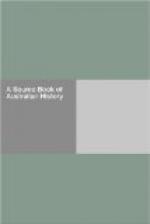About 10 a.m. I took my departure from these interesting people. The principal chief could not be less than six feet four inches high, and his proportions gigantic; his brother six feet two inches, also a fine man. I recrossed Batman’s Creek, and travelled over thinly-timbered country of box, gum, wattle, and she-oak, with grass three of four feet high. Travelling twelve miles down we came, subsequently, upon a thinly-timbered forest of gum, wattle and oak. Here, for the first time, the land became sandy, with a little gravel. The grass was ten inches high, and resembled a field of wheat. We have not seen the slightest appearance of frost. After leaving this forest, we came upon the river I had gone up a few days before. Intending to come down on the opposite side and hail the vessel, I crossed on the banks of the river, a large marsh, one mile and a half broad by three or four long, of the richest diluvium; not a tree was to be seen. Having crossed this marsh we passed through a dense tea-tree scrub, very high, expecting to make the vessel in the course of an hour or two, but, to our great surprise, when we got through, we found ourselves on the banks of a much larger river than the one we had originally gone up.
As it was now near sundown, and at least two days would be required to head the river, I decided upon allowing two of my Sydney natives to swim across it, and go to the vessel, distant about seven miles, to fetch the boat. Bullet and Bungit started on this enterprise, and returned in about three hours from the time of their departure. Their return with the boat was most opportune as we had got on the point of junction of the two rivers, where the tide had set in, and was already up to my ankles. I first despatched the party with the dogs in the boat




